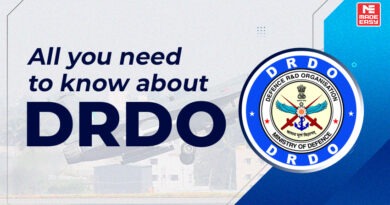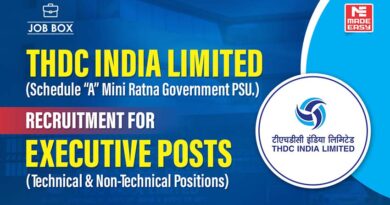GATE vs ESE – Key Differences & Similarities Explained
The Graduate Aptitude Test in Engineering, popularly known as GATE, and Engineering Services Examination, popularly known as ESE, are the two most important as well as popular exams for engineering graduates who are aspiring to work in the government sector or those who want to pursue higher studies.
Both GATE and ESE are among the most challenging exams in India. Aspirants who want to pursue a career in their technical sectors have a hard time deciding between these two examinations.
Opportunities and avenues through these two exams are different. In addition, preparation strategies and approaches for these exams are a little different. In this blog, we try to pin down all the differences in the paper pattern and various other aspects between the GATE exam pattern and the ESE pattern. This blog on GATE vs. ESE aims to help aspirants make an informed decision about whether they should prepare for GATE/ESE or for both.
Eligibility and Syllabus:
GATE exam is held for various engineering as well as non-engineering disciplines whereas ESE is conducted for only four core engineering branches namely Civil Engineering, Mechanical Engineering, Electrical Engineering, and Electronics and Telecommunication Engineering. It is one of the major differentiating point discussed in terms of GATE vs ESE.
Allied branches to these four core branches, like Production and Industrial Engineering, can apply for posts available for Mechanical Engineers and Instrumentation Engineers, and Computer Science graduates can apply for posts in Electronics and Telecommunication Engineering.
ESE and GATE do not demand candidates to have a bachelor’s degree in the same discipline in which they have applied for the examination. Subjects asked in GATE and ESE for some branches are the same, whereas the ESE syllabus and pattern for some branches are wider in scope.
Apart from the technical subjects of the respective branches, Paper-1 of ESE contains 10 subjects to check the general knowledge that an engineering graduate must possess, whereas GATE checks aptitude, reasoning, English, and engineering mathematics other than subjects of respective technical discipline.
Distribution of marks:
ESE has 3 stages, stage 1 is the preliminary exam, stage 2 is the mains exam and stage 3 is the personality test. Preliminary exam has 2 papers, paper 1 and paper 2.
Paper-1 of ESE prelims tests the candidate’s General Knowledge and has a weightage of 200 marks, whereas the paper 2 which is technical section in stage-1 is of 300 marks.
The two conventional papers in the second stage, that check the technical knowledge of a candidate, are both 300 marks each. The interview, which is the last stage, has a weightage of 200 marks. ESE total marks round up to 1300 marks.
GATE, on the other hand, is a 100-mark paper in total. Aptitude and Engineering Mathematics both have a combined weightage of almost 30 marks, where the number of questions asked from Engineering Mathematics varies from 8 to 10 each year.
The rest of the paper is to test the technical aptitude of a candidate. Another key point one must note while discussing GATE vs ESE is the type of questions asked and the weightage of each section in the respective exams.
Types of questions:
Questions asked in GATE are either MCQ (Multiple Choice Questions), MSQs, or NAT (Numerical Answer Type). MCQs will have four options for every question, and the candidate is expected to choose the most appropriate answer from them. In case of a wrong answer, the checker penalizes the exam taker with negative marks.
NAT is generally a numerical problem. The answer to such a type of question is a real number. Similarly, the MSQs can have multiple correct answers. GATE exam takers need to use a mouse and virtual keypad displayed on the monitor to add the number. There is no negative marking for these questions.
There are 35 questions of 2 marks each and 30 questions of 1 mark. Therefore, 65 questions are present in this exam.
The question paper of the ESE Preliminary exam has only MCQ-type questions of equal weightage. There are 100 and 150 questions, each of 2 marks, in Paper 1 and Paper 2 of the ESE prelims, respectively. It is one of the major points associated with the analysis of GATE vs ESE.
In both GATE and ESE, a deduction of one-third of the total marks occurs in case of a wrong answer. The other stages of ESE do not have negative marking, as the questions in these stages are subjective. On the other hand, GATE aspirants must be cautious of the negative marking pattern in the exam.
In the Mains stage of ESE, questions are subjective in nature and each question includes several sub-parts. The main deciding factor of GATE vs ESE lies in the ESE Mains stage. Here, writing skills, presentation, and time-bound planning play a crucial role.
The preparation and approach for GATE and ESE remain almost the same until ESE Prelims. After that, however, the approach for ESE Mains becomes completely different from the GATE exam. This is a key deciding factor for candidates choosing between the two.
Aspirants need to work on writing structured answers, drawing diagrams, including codes, flowcharts, etc., all within the limited space provided in the QCAB (Question-cum-Answer Booklet).
Mode and conduct of examination:
All the stages of ESE are conducted offline, whereas GATE is completely an online examination. Aspirants are required to solve 65 questions in three hours in the GATE exam with the help of an on-screen virtual calculator.
In ESE, however, exam takers must solve 100 and 150 questions in 2 and 3 hours, respectively, in Prelims without using calculators. This implies that the level of questions asked in ESE Prelims is comparatively lower than in the GATE exam. However, most of the aspirants think that Mains-level questions of ESE are tougher than those of GATE.
While talking about ESE vs. GATE, questions in the ESE exam involve memory testing with minimum calculation, which is not the case in the GATE exam. Exam takers can use scientific calculators in the Mains stage of ESE. These papers are subjective in nature, and students need to write the answers to these questions in QCAB. It’s a consolidated booklet with questions printed on them and a fixed allotted space to write answers for respective questions. The third tier of ESE is the personal interview.
The approach in the exam:
Since the mode of exam conduction is different for the two exams, students must prepare for and approach the two examinations differently. One must practice questions for ESE Prelims without using a calculator from the start itself and, if possible, with the help of OMR sheets.
Joining an offline test series for each stage of the exam adds to the practice and prepares an aspirant best for the exam day. Giving tests in an exam-like environment helps train the mind to work with maximum efficiency in the actual exam setting.
Practicing filling out OMR sheets and writing in the QCAB—both of which can come from test series—is unavoidable.
For GATE, since students can use a virtual calculator in the exam and the authorities conduct the exam via online mode, it is highly recommended that one enroll in a good online test series like MADE EASY to practice well for the exam.
Other than test series, one must also practice working on the virtual calculator from the start itself on a laptop or computer screen to avoid any blunders on the exam day.
Therefore, if you are preparing for both GATE and ESE, you must analyse GATE vs. ESE in terms of the right approach to prepare for these examinations.
Examination tiers:
The ESE is conducted in various stages, whereas GATE is a single-stage examination. Time is a critical factor that determines the GATE vs. ESE. Therefore, you must consider the time constraints before starting with your GATE or ESE exam preparation.
The concerned authorities conduct the preliminary stage of ESE around the first week of January in two slots of 2 hours and 3 hours for Paper 1 of GS and the technical paper associated with the chosen engineering stream, respectively.
After prelims, qualified candidates have to appear for Mains around May. The Mains exam comprises two conventional papers to test the technical knowledge of a candidate in two sittings of three hours each. After clearing the cutoff of the two stages together, the qualified candidates sit for the interview round. This round takes place around the month of October. The results are declared around November. The joining of the selected candidates starts in June of the upcoming year. This makes the total duration of the ESE exam over a year.
The benefit of the GATE exam here is that it is not so demanding in terms of time. The authorities conduct the exam around February, and the results are out within a month or so. After which candidates can prepare for interviews (group discussions also in some cases) and apply for their target PSUs or M. Tech colleges.
Cutoff and topper’s marks:
Qualifying marks in GATE are not more than around one-third, varying branch to branch in any year. Although GATE marks do not provide an accurate idea of one’s performance, the GATE score does. Since the GATE exam is conducted in multiple sessions for some branches, a candidate may score fewer marks due to the toughness of that set. After normalization, the GATE score can help to compare the performance of two different candidates in different sessions.
In addition, merely qualifying for GATE does not guarantee any placement or allotment to any college for higher studies. In ESE, though, the qualification of a candidate implies allotment of services in a government department, based on the candidate’s preference and ranks. The number of qualified candidates in ESE is fixed and pre-decided, based on the number of available vacancies in various government departments in that particular year. It keeps on changing every year.
Qualifying marks in ESE, for general candidates, fall a little more than around 50% of the total marks, which is in the range of 700 marks or so.
Post Exam:
Before one decides to opt for one of these exams, it is important to know the opportunities available after clearing these examinations.
After the results of the GATE exam are declared, the GATE scorecard is valid for three years. It means that a candidate can apply for admissions in M.Tech, MS, etc., until three years after clearing the GATE exam. However, PSUs generally accept the GATE score of the respective year of application.
This is not the case with ESE. If a selected candidate refuses to join in that particular year in which he qualified, he has to rewrite the exam again to receive a job offer via the ESE exam.
In addition, government departments like railways, PWD, store services, Indian naval armament services, etc., are the various departments allocated to ESE-qualified candidates.
Whereas aspirants who score a decent rank in GATE have multiple opportunities in several PSUs or pursue higher education like M. Tech, junior research fellow, etc. from top colleges in India and abroad.
Apart from all the factors listed above, GATE and ESE exams are similar in factors such as the same amount of effort, hard work, and determination to crack these exams.
Few differences lie in the approach and preparation strategies for the two exams. During detailed GATE vs. ESE exam analysis, GATE is the subset of ESE.
There have been multiple success stories in the past where students have cracked both exams in the same year with amazing results.
So, plan diligently and choose the one that will guide you towards achieving your goal. Stay motivated enough to put in whatever it takes to achieve your aim after that.
Hope this blog helps all the aspirants to analyse and understand the key differences in paper patterns of GATE vs. ESE, thus helping aspirants take an informed decision regarding their exam attempt and preparation.
All the very best!
FAQs:
1. Which is more tough, GATE or ESE?
Answer: Both exams are challenging; it depends upon the aspirant which exam they are targeting and what their aim is. If prepared well, neither of the exams is tough.
2. What is the basic salary after clearing ESE?
Answer: The basic pay after clearing ESE is Rs. 56100 as per the 7th pay commission. Selected candidates get TA, DA, HRA and many other allowances along with the basic pay.
3. Is engineering services a gazetted post?
Answer: Yes, engineering services is a gazetted post.
4. Which PSUs accept GATE score card for recruitment?
Answer: PSUs like ONGC, IOCL, PGCIL and many others accept GATE score card for recruitment of engineering candidates for the post of MT/AEE.
5. What is the main difference between GATE and ESE?
Answer: GATE is online exam for candidates aspiring to pursue higher studies or join PSUs, whereas ESE is an offline recruitment exam for various engineering services under the Government of India.
6. Can a candidate appear for both GATE and ESE exams?
Answer: Yes, a candidate can appear in both GATE and ESE.
7. What is the age limit for GATE?
Answer: There is no age limit for GATE. Anyone can appear in GATE.





I am a college going student . I have to appear in gate exam in 2020 . I have joined made easy in two year class room program . So i am confused when is the best time to join the test series of made easy .
Dear Abhay,
Thanks for writing to us. The right time to join the Test Series is a very subjective thing as depends on a lot of factor like the level of your preparation and the time you can take out each day for the tests. Ideally, one should start giving tests along with the classes so that your concepts are sound. Once a subject is completed, you can take the test related to the subject. This will help you in getting a good grasp over the subject matter.
Regards,
Team MADE EASY
Made easy blogs are very motivating to us. Sir please write a blog on these two topics..
1:How to stay motivated throughout a year.
1: Hard work importance
Dear Rishi,
Thanks for writing to us. We will take your suggestion into consideration while writing blogs in the future. Meanwhile, keep reading our blog to get a better insight about the exams.
Regards,
Team MADE EASY
How to prepare for the ESE exam ?
Now I am in 3rd semester.( Electronics and communication engineering)
What are the study material ?
Please write to me..
i have a little doubt i take admission in made easy but i take admission in ese (15th jan batch) for only gate subjects please tell me that is this good thing or there is some extra syllabus in gate which is not in ese
as i m only preparing for gate 2020
Bro mujhe bhi batana agar jabab mil jaye to mai bhi isme confused hu. Ye mera no hai-9592487091(whap/sms/call)
Maine bhi ese lene ka hi socha hai aur mujhe gate ka syllabus bhi cover krna hai to syllabus different hogi tab to dikkat ho jayegi.
Please bro batana jaroor
Abhi to padh hi rahoge uss hisab se to pata chal hi gya hoga ki kya pattern hai padhane ka
I am btech 1st year student.Is postal study package for gate cs good for me and will i get work books if yes then there is any explanation or not? Plz do reply..
Dear Candidate,
Thanks for writing to us. The Postal Study Package can be a great help for a student in 1st year as it contains all the required books which will cover your fundamentals. This will be accompanied by numerical questions to make your concepts even stronger.
Regards,
Team MADE EASY
I have taken admission for gate exclusive course ,, starting from 20 Feb is there any way to change it to gate +ies
Dear Candidate,
Thanks for writing to us. Please consult using the following contact information in order to get the required information.
Regards,
Team MADE EASY
It is a great blog post.I am always read your blog helpful and informative tips. I like it thanks for sharing this information with us
Dear Anil,
Thank You for your valuable feedback. Request you to stay tuned to our website blog.madeeasy.in for more informative content.
Regards,
Team MADE EASY